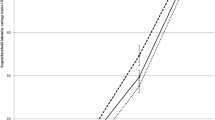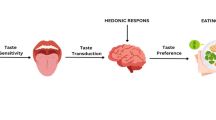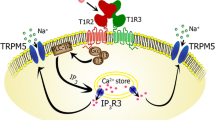Abstract
Purpose
Few and contradictory data suggest changes in taste perception in type 2 diabetes (T2DM), potentially altering food choices. We, therefore, analyzed taste recognition thresholds in T2DM patients with good metabolic control and free of conditions potentially impacting on taste, compared with age-, body mass index-, and sex-matched normoglycemic controls.
Methods
An ascending-concentration method was used, employing sucrose (sweet), sodium chloride (salty), citric acid (sour), and quinine hydrochloride (bitter), diluted in increasing concentration solutions. The recognition threshold was the lowest concentration of correct taste identification.
Results
The recognition thresholds for the four tastes were higher in T2DM patients. In a multiple regression model, T2DM [β = 0.95; 95% CI 0.32–1.58; p = 0.004 (salty); β = 0.61; 0.19–1.03; p = 0.006 (sweet); β = 0.78; 0.15–1.40; p = 0.016 (sour); β = 0.74; 0.22–1.25; p = 0.006 (bitter)] and waist circumference [β = 0.05; 0.01–0.08; p = 0.012 (salty); β = 0.03; 0.01–0.05; p = 0.020 (sweet); β = 0.04; 0.01–0.08; p = 0.020 (sour); β = 0.04; 0.01–0.07; p = 0.007 (bitter)] were associated with the recognition thresholds. Age was associated with salty (β = 0.06; 0.01–0.12; p = 0.027) and BMI with sweet thresholds (β = 0.06; 0.01–0.11; p = 0.019).
Conclusions
Taste recognition thresholds were higher in uncomplicated T2DM, and central obesity was significantly associated with this impairment. Hypogeusia may be an early sign of diabetic neuropathy and be implicated in the poor compliance of these patients to dietary recommendations.
Similar content being viewed by others
References
Rivellese AA, Boemi M, Cavalot F, Costagliola L, De Feo P, Miccoli R, Patti L, Trovati M, Vaccaro O, Zavaroni I (2007) Dietary habits in type II diabetes mellitus: how is adherence to dietary recommendations? Eur J Clin Nutr 62:660–664
Loper HB, La Sala M, Dotson C, Steinle N (2015) Taste perception, associated hormonal modulation, and nutrient intake. Nutr Rev 73:83–91
Le Floch JP, Le Lievre G, Sadoun J, Perlemuter L, Peynegre R, Hazard J (1989) Taste impairment and related factors in type I diabetes mellitus. Diabetes Care 12:173–178
Perros P, Counsell C, Mac Farlane TW, Frier BM (1996) Altered taste sensation in newly-diagnosed NIDDM. Diabetes Care 19:768–770
Wasalathanthri S, Hettiarachchi P, Prathapan S (2014) Sweet taste sensitivity in pre-diabetics, diabetics and normoglycemic controls: a comparative cross-sectional study. BMC Endocr Disord 14:67. https://doi.org/10.1186/1472-6823-14-67
Noel CA, Sugrue M, Dando R (2017) Participants with pharmacologically impaired taste function seek out more intense, higher calorie stimuli. Appetite 117:74–81. https://doi.org/10.1016/j.appet.2017.06.006
Gondivkar SM, Indurkar A, Degwekar S, Bhowate R (2009) Evaluation of gustatory function in patients with diabetes mellitus type 2. Oral Surg Oral Med Oral Pathol Oral Radiol Endod 108:876–880. https://doi.org/10.1016/j.tripleo.2009.08.015
Cho H, Kim SM, Jeong SS, Kim SB (2016) Comparison of salt taste thresholds and salt usage behaviours between adults in Myanmar and Korea. Asia Pac J Clin Nutr 25:879–884. https://doi.org/10.6133/apjcn.092015.32
Roura E, Foster S, Winklebach A, Navarro M, Thomas W, Campbell K, Stowasser M (2016) Taste and hypertension in humans: targeting cardiovascular disease. Curr Pharm Des 22:2290–2305
Hardy SL, Brennand CP, Wyse BW (1981) Taste thresholds of individuals with diabetes mellitus and of control subjects. J Am Diet Assoc 79:286–289
Negrato CA, Tarzia O (2010) Buccal alterations in diabetes mellitus. Diabetol Metab Syndr 15:2–3. https://doi.org/10.1186/1758-5996-2-3
Pavlidis P, Gouveris H, Kekes G, Maurer J (2014) Electrogustometry thresholds, tongue tip vascularization, and density and morphology of the fungiform papillae in diabetes. B-ENT 10:271–278
Martin B, Dotson CD, Shin YK, Ji S, Drucker DJ, Maudsley S, Munger SD (2009) Modulation of taste sensitivity by GLP-1 signaling in taste buds. Ann N Y Acad Sci 1170:98–101. https://doi.org/10.1111/j.1749-6632.2009.03920.x
Fournel A, Marlin A, Abot A, Pasquio C, Cirillo C, Cani PD, Knauf C (2016) Glucosensing in the gastrointestinal tract: impact on glucose metabolism. Am J Physiol Gastrointest Liver Physiol 310:G645–G658. https://doi.org/10.1152/ajpgi.00015.2016
Abbasi AA (1981) Diabetes: diagnostic and therapeutic significance of taste impairment. Geriatrics 36:73–78
Naka A, Riedl M, Luger A, Hummel T, Mueller CA (2009) Clinical significance of smell and taste disorders in patients with diabetes mellitus. Eur Arch Otorhinolaringol 267:547–550. https://doi.org/10.1007/s00405-009-1123-4
Naik BS, Shetty N, Maben EVS (2010) Drug-induced taste disorders. Eur J Intern Med 21:240–243. https://doi.org/10.1016/j.ejim.2010.01.017
ASTM Standard E679-04 (2011) Standard practice for determination of odor and taste thresholds by a forced-choice ascending concentration series method of limits. ASTM [online] Available at: http://www.astm.org. Accessed 22 Nov 2017
Lawless HT, Heymann H (1998) Sensory evaluation of food: principles and practices. Chapman & Hall, New York, pp 181–185
Bloomfeld RS, Graham BG, Schiffman SS, Killenberg PG (1999) Alterations of chemosensory function in end-stage liver disease. Physiol Behav 66:203–207
Borgnakke WS, Anderson PF, Shannon C, Jivanescu A (2015) Is there a relationship between oral health and diabetic neuropathy? Curr Diab Rep 15:93. https://doi.org/10.1007/s11892-015-0673-7
Sandberg GE, Sundberg HE, Fjellstom CA, Wikblad KF (2000) Type 2 diabetes and oral health. A comparison between diabetic and non-diabetic subjects. Diabetes Res Clin Pract 50:27–34
Henkin RI, Martin BM, Agarwal RP (1999) Decreased parotid saliva gustin/carbonic anhydrase VI secretion: an enzyme disorder manifested by gustatory and olfactory dysfunction. Am J Med Sci 318:380–391
Bromley SM (2000) Smell and taste disorders: a primary care approach. Am Fam Physician 61:427–436
Duda-Sobczak A, Araszkiewicz A, Urbas M, Borucki L, Kulas K, Chudzinski M, Suwalska A, Zozulinska-Ziolkiewicz D (2017) Impaired olfactory function is related to the presence of neuropathy in adults with type 1 diabetes. Diab Vasc Dis Res 14:139–143. https://doi.org/10.1177/1479164116679079
Gardiner J, Barton D, Vanslambrouck JM, Braet F, Hall D, Marc J, Overall R (2008) Defects in tongue papillae and taste sensation indicate a problem with neurotrophic support in various neurological diseases. Neuroscientist 14:240–250. https://doi.org/10.1177/1073858407312382
Kawaguchi HL, Murata K (1995) Electric gustatory threshold in diabetics and its clinical significance. Nihon Jibiinkoka Gakkai Kaiho 98:1291–1296
Le Floch JPL, Le Lièvre G, Labroue M, Peynègre R, Perlemuter L (1992) Early detection of diabetic patients at risk of developing degenerative complications using electric gustometry: a five-year follow-up study. Eur J Med 1:208–214
Laffitte A, Neiers F, Briand L (2014) Functional roles of the sweet taste receptor in oral and extraoral tissues. Curr Opin Clin Nutr Metab Care 17:379–385
Gaphor SM, Saeed RA (2014) The evaluation of taste threshold for four main tastes between diabetic and healthy individuals. ESJ 10:434–439
Fernandez-Garcia JC, Alcaide J, Santiago-Fernandez C, Roca-Rodriguez MM, Aguera Z, Baños R, Botella C, de la Torre R, Fernandez-Real JM, Fruhbeck G, Gomez-Ambrosi J, Jimenez-Murcia S, Menchon JM, Casanueva FF, Fernandez-Aranda F, Tinahones FJ, Garrido-Sanchez L (2017) Correction: an increase in visceral fat is associated with a decrease in the taste and olfactory capacity. PLoS ONE 3(12):e0171204. https://doi.org/10.1371/journal.pone.0171204
Maliphol AB, Garth DJ, Medler KF (2013) Diet-induced obesity reduces the responsiveness of the peripheral taste receptor cells. PLoS One 8:e79403. https://doi.org/10.1371/journal.pone.0079403
Stolbová K, Hahn A, Benes B, Andel M, Treslová L (1999) Gustometry of diabetes mellitus patients and obese patients. Int Tinnitus J 5:135–140
Hwang LD, Cuellar-Partida G, Ong JS, Breslin PA, Reed DR, MacGregor S, Gharahkhani P, Martin NG, Rentería ME (2016) Sweet taste perception is associated with body mass index at the phenotypic and genotypic level. Twin Res Hum Genet 19:465–471. https://doi.org/10.1017/thg.2016.60
Berthoud HR, Zheng H (2012) Modulation of taste responsiveness and food preference by obesity and weight loss. Physiol Behav 107:527–532. https://doi.org/10.1016/j.physbeh.2012.04.004
Niki M, Jyotaki M, Yoshida R, Ninomiya Y (2010) Reciprocal modulation of sweet taste by leptin and endocannabinoids. Results Probl Cell Differ 52:101–114. https://doi.org/10.1007/978-3-642-14426-4_9
Domingos AI, Vaynshteyn J, Voss HU, Ren X, Gradinaru V, Zang F, Deisseroth K, de Araujo IE, Friedman J (2011) Leptin regulates the reward value of nutrient. Nat Neurosci 14:1562–1568
Shin YK, Martin B, Golden E, Dotson CD, Maudsley S, Kim W, Jang HJ, Mattson MP, Drucker DJ, Egan JM, Munger SD (2008) Modulation of taste sensitivity by GLP-1 signaling. J Neurochem 106:455–463. https://doi.org/10.1111/j.1471-4159.2008.05397.x
Östberg AL, Bengtsson C, Lissner L, Hakeberg M (2012) Oral health and obesity indicators. BMC Oral Health 12:50. https://doi.org/10.1186/1472-6831-12-50
Drewnowski A, Henderson SA, Levine A, Hann C (1999) Taste and food preferences as predictors of dietary practices in young women. Public Health Nutr 2:513–519
Sergi G, Bano G, Pizzato S, Veronese N, Manzato E (2016) Taste loss in the elderly: possible implications for dietary habits. Crit Rev Food Sci Nutr 57:3684–3689. https://doi.org/10.1080/10408398.2016
Nordin S, Razani LJ, Markison S, Murphy C (2003) Age-associated increases in intensity discrimination for taste. Exp Aging Res 29:371–381
Tsujimoto T, Imai K, Kanda S, Kakei M, Kajio H, Sugiyama T (2016) Sweet taste disorder and vascular complications in patients with abnormal glucose tolerance. Int J Cardiol 221:647–648. https://doi.org/10.1016/j.ijcard.2016.07.062
Te Morenga LA, Howatson AJ, Jones RM, Mann J (2014) Dietary sugars and cardiometabolic risk: systematic review and meta-analyses of randomized controlled trials of the effects on blood pressure and lipids. Am J Clin Nutr 100:65–79. https://doi.org/10.3945/ajcn.113.081521
Dhurandhar NV, Thomas D (2015) The link between dietary sugar intake and cardiovascular disease mortality: an unresolved question. JAMA 313:959–960. https://doi.org/10.1001/jama.2014
Yang Q, Zhang Z, Gregg EW, Flanders WD, Merritt R, Hu FB (2014) Added sugar intake and cardiovascular diseases mortality among US adults. JAMA Intern Med 174:516–524. https://doi.org/10.1001/jamainternmed.2013.13563
Young RL, Chia B, Isaacs NJ, Ma J, Khoo J, Wu T, Horowitz M, Rayner CK (2013) Disordered control of intestinal sweet taste receptor expression and glucose absorption in type 2 diabetes. Diabetes 62:3532–3541. https://doi.org/10.2337/db13-0581
Boyce JM, Shone GR (2006) Effects of ageing on smell and taste. Postgrad Med J 82:239–241
Stevens JC, Cain WS (1993) Changes in taste and flavor in aging. Crit Rev Food Sci Nutr 33:27–37
Heft MW, Robinson ME (2010) Age differences in orofacial sensory thresholds. J Dent Res 89:1102–1105. https://doi.org/10.1177/0022034510375287
Cowart BJ, Yokomukai Y, Beauchamp GK (1994) Bitter taste in aging: compound-specific decline in sensitivity. Physiol Behav 56:1237–1241
Enns MP, Hornung DE (1988) Comparisons of the estimates of smell, taste and overall intensity in young and elderly people. Chem Senses 13:131–139
Salmon AB (2016) Beyond diabetes: does obesity-induced oxidative stress drive the aging process? Antioxidants 5:24. https://doi.org/10.3390/antiox5030024
Anderson CA, Cobb LK, Miller ER 3rd, Woodward M, Hottenstein A, Chang AR, Mongraw-Chaffin M, White K, Charleston J, Tanaka T, Thomas L, Appel LJ (2015) Effects of a behavioral intervention that emphasizes spices and herbs on adherence to recommended sodium intake: results of the SPICE randomized clinical trial. Am J Clin Nutr 102:671–679. https://doi.org/10.3945/ajcn.114.100750
Mattes RD, Popkin BM (2009) Nonnutritive sweetener consumption in humans: effects on appetite and food intake and their putative mechanisms. Am J Clin Nutr 89:1–14. https://doi.org/10.3945/ajcn.2008.26792
Ozcariz SG, Bernardo Cde O, Cembranel F, Peres MA, González-Chica DA (2015) Dietary practices among individuals with diabetes and hypertension are similar to those of healthy people: a population-based study. BMC Public Health 15:479. https://doi.org/10.1186/s12889-015-1801-7
Author information
Authors and Affiliations
Corresponding author
Ethics declarations
Ethical approval
All procedures performed in this study involving human participants were in accordance with the ethical standards of the institutional and/or national research committee and with the 1964 Helsinki declaration and its later amendments or comparable ethical standards.
Informed consent
Informed consent was obtained from all individual participants included in the study.
Conflict of interest
On behalf of all authors, the corresponding author states that there is no conflict of interest.
Funding
The authors have no financial relationships relevant to this article to disclose.
Rights and permissions
About this article
Cite this article
De Carli, L., Gambino, R., Lubrano, C. et al. Impaired taste sensation in type 2 diabetic patients without chronic complications: a case–control study. J Endocrinol Invest 41, 765–772 (2018). https://doi.org/10.1007/s40618-017-0798-4
Received:
Accepted:
Published:
Issue Date:
DOI: https://doi.org/10.1007/s40618-017-0798-4




